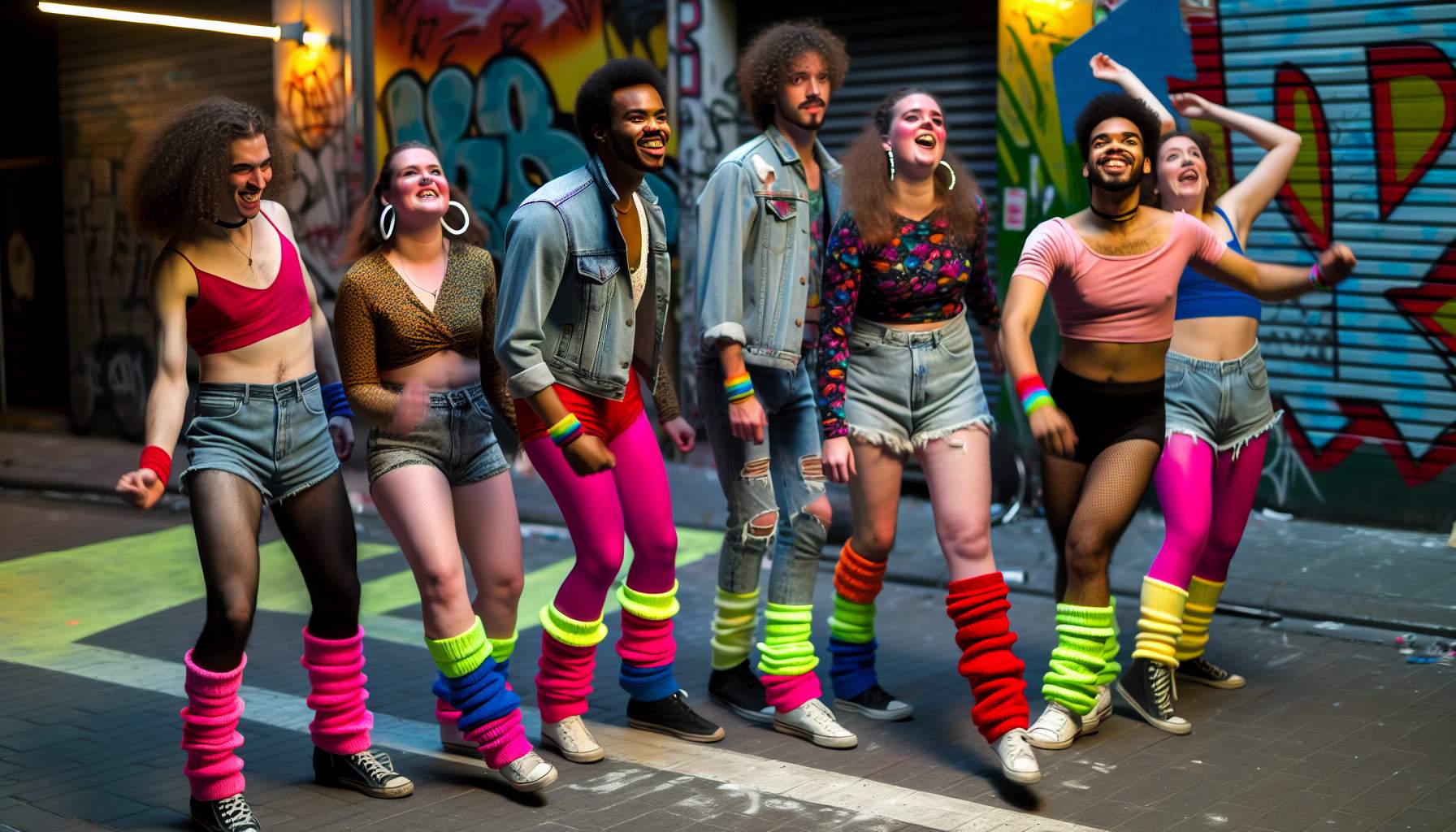
how to draw leg warmers in 2025
Ready to enhance your fashion illustration skills? This guide dives into the art of drawing cozy yet stylish leg warmers. Perfect for budding artists and fashion enthusiasts alike, you’ll learn step-by-step methods to bring your sketches to life. Grab your pencils, and let’s start creating some fashionable sketches that pop!
Discover our collections of trendy leggings
Understanding leg warmers in fashion
Leg warmers emerged as a vital accessory in the dance world, especially popular during the 1980s aerobics boom. In modern fashion, they have transcended their practical use to become a stylish symbol of retro and contemporary trends. These accessories adapt to various styles, from athletic to chic, making them a versatile topic for fashion illustration. Understanding how to sketch leg warmers with accurate proportions and textures enhances your ability to capture their essence in your fashion drawings.
Historical significance of leg warmers
- Ballet dancers originally wore leg warmers to prevent muscle injuries.
- During the 1980s, leg warmers became a fashion trend due to their visibility in dance movies.
- Leg warmers showcased a blend of practicality and style, enhancing outfits while providing warmth.
- They symbolized the aerobics craze and were often paired with leotards and headbands.
- Knitted patterns and bright colors in leg warmers reflected personal style and youth culture.
- Today, they influence modern fashion by adding a retro touch to contemporary outfits.
Leg warmers in modern fashion trends
Leg warmers have evolved as a trendy accessory beyond the ballet studio. In modern fashion, they appear in vibrant colors and varied textures, often layered over leggings or paired with boots for an edgy look. This style statement enhances both warmth and fashion flair, proving its versatility in contemporary wardrobes.
Materials and tools for drawing
Selecting the right materials and tools is crucial for your drawing leg warmers tutorial. Here’s what you’ll need:
- Sketching Pencils: Opt for a variety of hardness levels, such as 2H for light outlines and 4B for dark shadows.
- High-Quality Paper: Choose a smooth, thick paper to prevent bleeding and allow easier blending.
- Blending Tools: Use blending stumps or a piece of felt to smooth out pencil marks and create gradient textures.
These essentials will help you achieve detailed and realistic illustrations of leg warmers.
Choosing the right sketching pencils
Selecting the right sketching pencils is crucial for capturing the subtle textures and contours of leg warmers. Opt for a range of HB to 4B pencils to achieve varying degrees of shading and detail. Always sharpen your pencils to ensure precise lines. A mechanical pencil might serve well for fine details, especially in intricate knit patterns.
Importance of quality paper
Choosing the right paper is crucial for your drawing leg warmers tutorial. Opt for a smooth, heavyweight paper that can handle repeated erasing and blending without tearing. Quality paper ensures your pencil strokes and textures appear crisp and clear, enhancing the overall look of your fashion illustrations. This choice impacts the final presentation and durability of your artwork.
Using erasers and blending tools
To achieve a realistic texture in your drawing leg warmers tutorial, using erasers and blending tools is crucial. Start by lightly applying pencil to outline the basic shape. Use an eraser to soften edges and create gradients, which mimic the softness of the fabric. Blending stumps or tortillons are perfect for smoothing out the pencil, enhancing the leg warmers’ fluffy appearance. Remember, gentle strokes prevent damage to your quality paper and keep the sketch refined. 🎨.
Basic techniques for drawing leg warmers

- Start by sketching a cylindrical shape around the leg area, ensuring it tapers near the ankle for a snug fit.
- Add vertical lines to represent the ribbed texture typical of leg warmers.
- Use light strokes to sketch folds at the top and bottom, where the fabric typically gathers.
- Apply different pressures with your pencil to create depth, making the texture more realistic.
- Review your drawing to ensure the proportions match the leg’s anatomy, adjusting as necessary for realism.
Sketching the basic shape
Start by drawing two elongated ovals to represent the calf area, ensuring they slightly taper near the ankles. This forms the basic outline of your leg warmers. Use light strokes to establish these initial shapes, as you’ll refine them later. Consider the elasticity of the material; leg warmers often hug the leg snugly. Make sure the top and bottom edges of the leg warmers show some curve, mimicking the natural shape of the leg. This approach helps you set up a solid foundation for adding intricate details and textures in subsequent steps.
Adding details and textures
To add details and textures to your leg warmers drawing, start by sketching light horizontal lines to mimic the knit pattern. Use a fine pencil to layer crosshatching for a textured look. Focus on areas where shadows fall, enhancing the 3D effect. Use smudging tools sparingly to blend and soften the textures, ensuring the leg warmers appear lifelike and fluffy. 🎨.
Creating volume and depth
To create volume and depth in your drawing of leg warmers, start by highlighting the curves around the calves and ankles. Use shading techniques to enhance these areas, making the fabric appear more realistic. Employ cross-hatching for textured depth and smudging to soften edges, giving the leg warmers a three-dimensional look. Ensure the light source is consistent to maintain the illusion of depth. 🎨.
Advanced drawing techniques
To master fabric folds and creases when drawing leg warmers, observe the way fabric naturally bunches around the ankles and calves. Depict various materials and knits by studying their unique textures; wool appears fluffy and thick, while acrylic shows smoother lines. Apply highlighting and shading techniques to enhance realism, using darker shades within the folds and lighter tones on raised surfaces. This approach not only adds depth but also brings your fashion illustrations to life.
Mastering fabric folds and creases
To master fabric folds and creases in drawing leg warmers, focus on observing how light and shadow interact on textured surfaces. Use varied pencil pressure to mimic the natural undulations of the material. This approach not only enhances realism but also injects life into your fashion illustrations.
Depicting different materials and knits
To capture the essence of different materials and knits in your drawing of leg warmers, focus on these key aspects:
- Texture variation: Cotton appears smoother, while wool shows more fluffiness.
- Stitch detail: Highlight knit patterns like ribbing or cable knits to add realism.
- Light reflection: Silk reflects light sharply, unlike matte cotton.
- Color depth: Darker shades can help depict thicker, coarser materials.
Each material requires a unique approach to accurately convey its distinct characteristics in your artwork.
Highlighting and shading for realism
To achieve realism in your drawing leg warmers tutorial, focus on these shading techniques:
- Use cross-hatching to build depth.
- Apply soft gradients for a realistic texture.
- Highlight edges where light naturally hits.
Common mistakes and tips to avoid them
When drawing leg warmers, a common mistake involves misjudging proportions, which can distort the appearance. To avoid this, always measure the length and width relative to the body parts. Another frequent error is over-detailing the fabric textures, making the drawing appear unrealistic. Aim for a balanced approach by observing real fabric samples. Lastly, ensure symmetry and balance by periodically comparing both sides of your drawing. Utilizing a grid can help maintain alignment and proportion, enhancing the overall realism and aesthetic appeal of your fashion illustrations. 📏✨.
Proportion errors in drawing leg warmers
When you draw leg warmers, maintaining correct proportions is crucial. Start by measuring the length and width against the limb size of your figure to ensure they look natural. Avoid making the leg warmers too bulky or too tight, as this can distort the overall appearance. Use reference images to compare and adjust the proportions accurately. Remember, accurate scaling enhances the realism in your fashion illustrations. 👍.
Over-detailing fabric textures
When drawing leg warmers, a common mistake involves over-detailing fabric textures, which can overwhelm the visual clarity of your fashion illustration. To achieve a balanced look, focus on suggesting the texture rather than fully rendering each thread or stitch. Use light pencil strokes to create a hint of the knitted pattern. This approach not only saves time but also keeps your drawing neat and stylish. Remember, less is more when it comes to effectively communicating texture in fashion sketches.
Tips for maintaining symmetry and balance
To ensure symmetry in your drawing of leg warmers, always start by marking the midpoint on your sketch paper. Use guidelines to mirror the shape and dimensions on both sides. Check balance by flipping your drawing upside down; this trick highlights any disproportion or skewing. Keep your strokes light to make adjustments easier. 📏.
Popular Questions
What type of pencils work best for sketching leg warmers?
For the best results, use a set of high-quality graphite pencils ranging from 2H to 6B. This range allows for fine lines and rich shading, essential for capturing the texture of leg warmers.
How can I accurately depict the texture of knitted leg warmers?
Start by lightly sketching the knit pattern with a 2H pencil. Gradually build up the texture with darker pencils, using small, interconnected V-shaped strokes to mimic the knit. Pay attention to light and shadow to enhance the realism.
What common mistake should I avoid when drawing leg warmers?
Avoid drawing leg warmers too stiff or straight; they should conform to the contours of the legs. Ensure to represent their elastic nature and how they bunch and fold around the leg joints.
Can you suggest a technique for adding volume and depth to leg warmers in a drawing?
To add volume, emphasize the shadows under the folds and where the leg warmers meet the shoes or ankles. Use a blending stump to soften these shadows, creating a three-dimensional effect that makes the leg warmers pop out from the page.




Laisser un commentaire